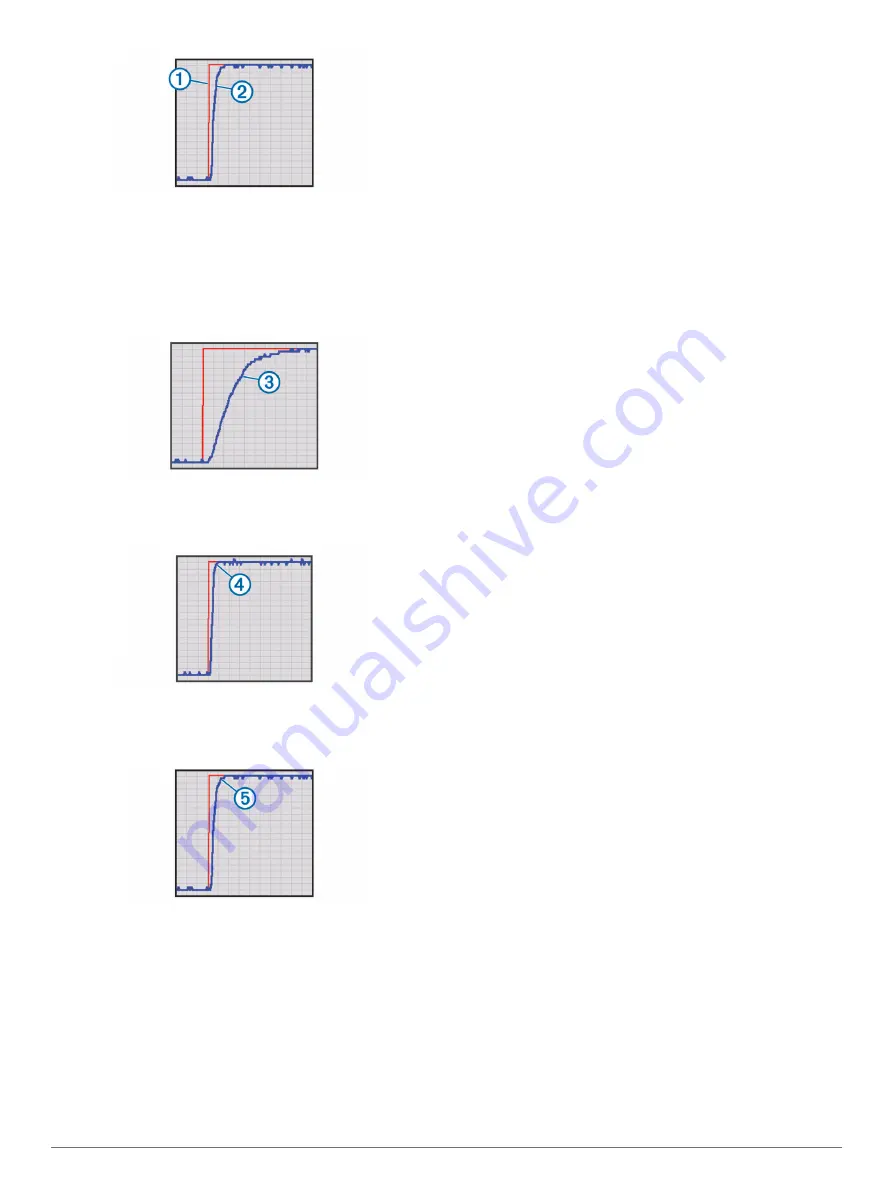
3
Select
Tune
, and observe the graph.
• The intended rudder position (indicated by the red line)
moves from +5° to -5° each time you select Tune, and the
drive unit steers the rudder accordingly (indicated by the
blue line).
• If the drive-unit-speed value is set too low, it responds
slowly. After you select Tune, the blue line draws a large
slope
Â
to the red line.
• If the drive-unit-speed value is set too high, it reacts
immediately and might force the rudder to the stops
quickly. After you select Tune, the blue line draws a hard
straight line that hits the red line without a slope
Ã
.
• If the drive unit speed is configured correctly, it reacts
quickly and eases into the stop. After you select Tune, the
blue line draws a straight line with a small slope
Ä
as it
approaches the red line.
4
If necessary, select
Adjust
.
5
Select an option:
• If the drive-unit-speed value is set too low, increase the
value and repeat step 3.
• If the drive-unit-speed value is set too high, decrease the
value and repeat step 3.
6
After the drive-unit speed is tuned correctly, select
Done
.
Tuning the Error Tolerance on an Existing Drive Unit
The error tolerance of the drive unit determines how much error
the autopilot allows before adjusting the drive unit.
If you set the error tolerance too low, the drive unit will react to
the slightest course deviation. This causes the drive to work
harder and may drain your battery at a faster-than-normal
speed.
If you set the error tolerance too high, the drive unit will not react
until your course is off a significant distance. This causes a less
reliable heading hold, and can result in unnecessarily large
course corrections.
1
From the heading screen, select
Menu
>
Setup
>
Dealer
Autopilot Configuration
>
Steering System Setup
>
Drive
Unit Class
.
2
Select
Other
or
Solenoid
, according to your selection in the
Dockside Wizard
.
3
Select
Advanced Tuning
>
Tune Error Tolerance
.
4
Center the rudder position, let go of the rudder control, and
select
Begin
.
5
Select
Tune
.
The rudder position moves from +5° to -5° each time you
select Tune, and the drive unit steers the rudder accordingly.
6
After the drive unit stops, observe the
Rudder Error
and
Power Usage
fields for 30 seconds.
• If the Power Usage field fluctuates, then your error
tolerance is set too low.
• If the Power Usage field stays at 0%, but the Rudder Error
field shows and unacceptable degree of error (1% or
more), then your error tolerance is set too high.
• An ideal error-tolerance configuration holds the rudder at
an acceptable degree of error (.5% or so) without
unnecessarily adjusting the drive unit and wasting power
(0% for 30 seconds or more).
7
If necessary, select
Adjust
and select an option:
• If the drive-unit error-tolerance is set too low, increase the
value and repeat steps 3 through 6.
• If the drive-unit error-tolerance is set too high, decrease
the value and repeat steps 3 through 6.
8
After the drive-unit error-tolerance is tuned correctly, select
Back
.
Appendix
NMEA 0183 Connection Diagrams
These wiring diagrams are examples of different situations you
may encounter when connecting your NMEA 0183 device to the
helm control.
NMEA 0183 Connection Considerations
• The installation instructions provided with your NMEA 0183
compatible device should contain the information you need to
identify the transmitting (Tx) and receiving (Rx) A (+) and B
(-) wires.
• When connecting NMEA 0183 devices with two transmitting
and two receiving wires, it is not necessary for the NMEA
2000 bus and the NMEA 0183 device to connect to a
common ground.
• When connecting a NMEA 0183 device with only one
transmitting (Tx) wire or with only one receiving (Rx) wire, the
NMEA 2000 bus and the NMEA 0183 device must be
connected to a common ground.
12
















